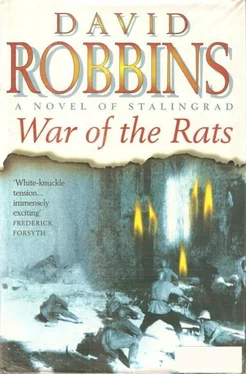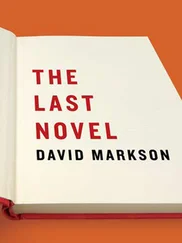Throughout January, German soldiers surrendered in groups of thousands. Appearing more like ragged scarecrows than men, they stumbled out of the mists and swirling snows, hands behind their heads, weapons dropped at their feet. Scraps of cloth bound their heads and boots. Starvation bulged in their darting eyes.
Despite the pitiful condition of the surrendering enemy troops, many of the Reds could not relinquish their burning hatred for the Nazis. Their anger had been stoked white hot by the invasion of their homeland, news of the Nazis’ cruelty in the occupied territories, the terrible, ongoing siege of Leningrad, and the rhetoric of loathing spread incessantly by the Communist agitators. Each Russian bore the pain of the rodina in the same hands he carried his machine gun.
Entire companies of Germans, Rumanians, Hungarians, and Italians were mowed down without remorse while they advanced under white flags. The murdering Russian units went unpunished, receiving the tacit and vengeful sanction of their generals and of Stalin to exterminate the enemy. By the third week of January, the Sixth Army, which two months earlier had numbered over three hundred thousand, had been massacred—starved, frozen, and hacked—to less than ninety thousand men.
On January 30, Hitler wired General Paulus that he had been promoted to the rank of field marshal, knowing that no German field marshal had ever surrendered his forces in battle. Hitler hoped that his beleaguered commander would take the hint and commit suicide, salvaging what Hitler deemed to be one final, heroic act. Paulus did not shoot himself; instead, before dawn, he surrendered to a young Russian lieutenant, Fyodor Yelchenko, who sat in a tank outside Sixth Army headquarters in the decimated Univermag department store, pointing his turret directly into Paulus’s window.
All organized German resistance in Stalingrad ended on February 2. Massive columns of prisoners streamed north out of the city. The captives shuffled across the Volga through blinding snow, then east to holding camps. Those who could not keep up with the march received a bullet in the skull from NKVD guards and were left beside the road.
The lines of prisoners passed through small villages untouched by the war. Though the Red Army had stopped the Wehrmacht at Stalingrad, the citizens east of the Volga displayed their hatred for the Germans as if they themselves had been in the grim battles. Old men and women broke into the prisoners’ limping ranks to slap at them or steal from them lighters, fountain pens, packs, hoarded bits of food, even writing paper. In several instances, Russian soldiers guarding the towns vented their wrath by firing indiscriminately into the trudging columns.
Bivouacs for the prisoners were set up along the way, rarely more than hastily-thrown-up tents, drafty barns, or windowless factory rooms. Straw was strewn on the ground for bedding. Each morning, fewer prisoners rose to continue the march east. Many of the men died in the night from starvation and cold. Typhus also struck them down, contracted from the lice riding in their crevices.
Finally, the survivors were loaded onto trucks and driven to labor camps across Siberia.
At the outset of the German invasion, Stalin had relocated many Soviet industries east of the Ural mountains. These factories needed rail links to the western half of the nation. The Axis prisoners were given inhuman burdens of labor, bending their backs over picks, shovels, and sledgehammers twelve hours a day in bitter Siberian weather. They went into tunnels to set dynamite charges. They split boulders and loaded the rocks onto truck beds or built retaining walls into the carved-away sides of mountains. Often at night, they were lectured by Communists about the evils of their governments and fascism. Many of the captives appeared to turn against their countries to cheer for world socialism. The louder they bellowed, the less cruel was their treatment. Doctors, nurses, food, clothes, even mail and some news appeared as the years moved past, making it plain that the Russians wanted some prisoners left alive to use for chips on the postwar world’s political gaming tables.
Not until 1948 did Russia release its first Stalingrad prisoners. The political pressures of the Cold War served to slow the repatriations to a trickle. Nonetheless, by 1954, only two thousand Germans remained in Siberian prison camps. These were men whom Premier Nikita Khrushchev identified not as prisoners of war but “war criminals,” men who had been tried and sentenced by Soviet tribunals for atrocities against the Russian people. After painstaking negotiations, these men, too, were finally amnestied and released.
Of the million and a quarter invading soldiers who rode across the Russian steppe to the gates of Stalingrad in August of 1942, fewer than thirty thousand ever returned to their homelands.
The author wishes to recognize and recommend the following historical works on Russia and the Battle of Stalingrad:
Beevor, Antony, Stalingrad: The Fateful Siege, 1942–1943. Viking, 1998.
Chuikov, Vasili I., The Battle for Stalingrad. Trans. H. Silver. Holt, Rinehart and Winston, 1964.
Clark, Alan, Barbarossa: The Russian-German Conflict, 1941–4 5. William Morrow, 1965.
Craig, William, Enemy at the Gates: The Battle for Stalingrad. Reader’s Digest Press, 1973.
Glantz, David M., and Jonathan M. House, When Titans Clashed: How the Red Army Stopped Hitler. University Press of Kansas, 1995.
Jukes, Geoffrey, Stalingrad: The Turning Point. Ballantine Books, 1968.
Keegan, John, The Second World War. Penguin Books, 1989.
Schroter, Heinz, Stalingrad. Trans. C. Fitzgibbon. E. P. Dutton, 1958.
Seth, R., Stalingrad: Point of Return. Coward-McCann, 1959.
Shipler, David K., Russia: Broken Idols, Solemn Dreams. Times Books, 1983.
Tantum, William, Sniper Rifles of Two Wars. Historical Arms Series no. 8. Museum Restoration Service, 1967.
Two Hundred Days of Fire: Accounts by Participants and Witnesses of the Battle of Stalingrad. Progress Publishers, 1970.
Werth, Alexander, Russia at War, 1941–194 5. E. P. Dutton, 1964.
-----------------------. The Year of Stalingrad. H. Hamilton, 1946.
Zaitsev, Vasily, Z a Volgoi zemli dlia nas ne bylo (For us, there was no land beyond the Volga). Moscow, 1971.
Fedya’s poem, “The Washing River,” is the work of Ms. Karen Johnston of Seattle and used by permission.
Amazon.com Review
David L. Robbins grimly recounts the merciless determination of the German and Soviet combatants of the battle of Stalingrad in War of the Rats . Drawing from real events, Robbins tells the story of one of the battle’s most pivotal contests: the famous sniper duel between Chief Master Sergeant Vasily Zaitsev and S.S. Colonel Heinz Thorvald. Zaitsev, a cunning Siberian hunter hardened by Stalingrad’s butchery, has formed an impromptu sniper school in the midst of the battle, training his comrades to kill with implacable efficiency. The hundreds of bodies left in their wake prompt the Nazi leadership to send Thorvald, the cold-blooded master of the Wehrmacht’s elite sniper academy, to assassinate the Soviet prodigy. Robbins’s nerve-wracking prose depicts the two adversaries as they pursue their private war across a twisted hellscape of burning tanks and gutted factories. In the novel’s most impressive section, Robbins leaps between the thoughts of Zaitsev and Thorvald as they struggle, in their final battle, to put the crosshairs on each other’s head. A war novel that reveals the shrewd savagery in human nature, War of the Rats vividly reveals why the Germans referred to the fighting at Stalingrad as Der Rattenkrieg .
Читать дальше












